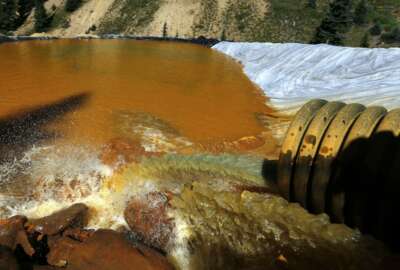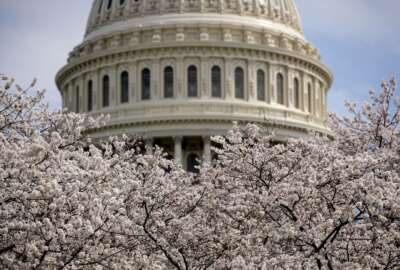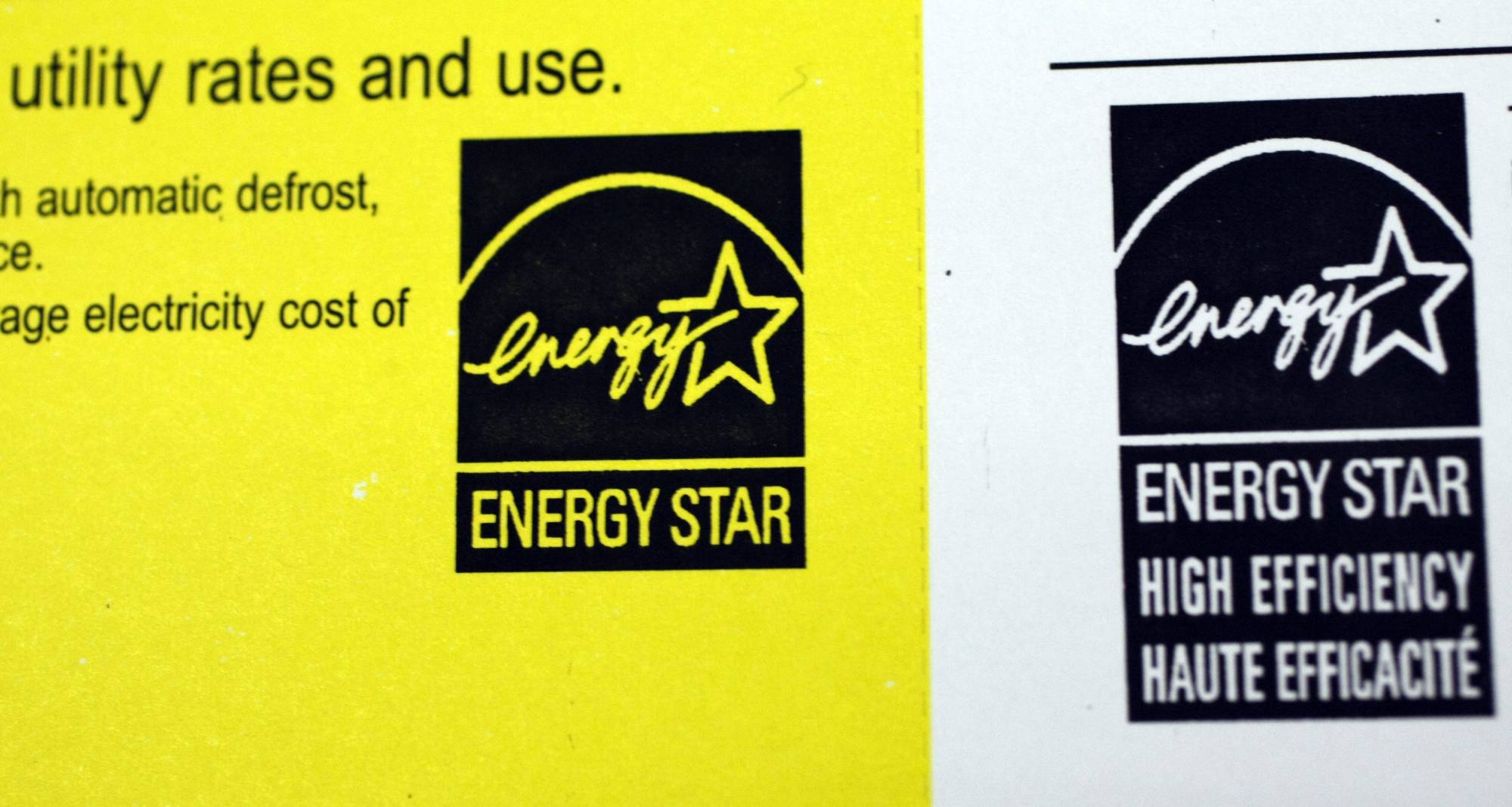
EPA’s Energy Star program rates huge data centers too, not just your fridge
You may or may not know that the Environmental Protection Agency is in the business of scoring and certifying the efficiency of huge data centers, along with common...
Best listening experience is on Chrome, Firefox or Safari. Subscribe to Federal Drive’s daily audio interviews on Apple Podcasts or PodcastOne.
If you’ve bought a major appliance in the last few decades, it’s probably come along with a sticker from the EPA’s Energy Star program rating its energy efficiency. But you might not know the EPA is also in the business of scoring and certifying the efficiency of huge data centers. The agency has just released the latest version of its certification standards for data centers. For more about how the program works, Federal Drive with Tom Temin and Federal News Network’s Jared Serbu talked to Ryan Fogle. He’s the data center product manager for Energy Star.
Interview transcript:
Jared Serbu: Ryan, welcome. Thanks for taking the time for this. And I guess let’s start with the news, which would have been the the new specifications that EPA announced for the Energy Star program and data centers in August, can you get us going just by talking about exactly what changed with the release of those specifications? What’s new here compared to the old regime?
Ryan Fogle: First off, just thank you very much for having me, I certainly appreciate the opportunity to talk data centers with you today. So for the new specification, this is for data center storage products. So these are purpose built data storage for applications where you need a lot of data storage capacity with high performance. So, think about if you do that online banking, a lot of banking institutions use data center storage, because obviously you want to access that information quickly. And there’s a lot of it out there. So that’s kind of one area where you would use it. So, when we did the version 1.0 specification, it was the first time that we really, anybody really looked at the energy efficiency of these products. So it was an exciting time, it also was a time of great learning. So we really wanted to take those lessons learned from version 1.0 of the specification and apply them to version 2.0 to make it a much better one. So there’s three kind of key ways that we looked at improving it and making it a stronger specification. So the first and probably the most exciting is that for the first time in the history of the program, we set up the efficiency criteria to differentiate products based on how well they worked when in their active mode. So essentially, for every watt of energy that goes into that product, how well does it do its job, and then differentiate those products that do the best. And that’s the first time that that’s really happened worldwide. In addition, we looked to simplify the test method, which made our partners very excited, and makes it a lot easier to test and certify these really complex and configurable products. And then the last big change was that we increase the options that data center owners could have to reduce the amount of data that needs to be stored. So there’s different technologies within the product that reduce duplication, compress the data. And depending on what you’re trying to do, and how you’re trying to do it, those options can also be huge energy saver, so it’s something that we really wanted to encourage.
Jared Serbu: And that active mode testing strikes me as something that’s probably pretty important in a data center context, right? Because the whole point of a data center is to maximize the utilization of the computing resources. So in that kind of environment, the assets gonna theoretically be in active mode most of the time, right?
Ryan Fogle: Yeah, ideally, it’ll be in active mode most of the time. That’s something that, broadly speaking in the data center, any sort of product within the data center not doing its job, i.e. being idle, is not really ideal for the data center owner, and it’s obviously not very ideal from an energy standpoint. We would prefer to have less products doing lots of work very efficiently.
Jared Serbu: So zooming out to the broader data center Energy Star program, can you talk a bit about some of what you’ve been able to achieve in data centers so far in terms of reducing energy utilization, even as the use of data centers has really exploded in the past couple decades?
Ryan Fogle: Yeah. And it’s really, it is a good story. Probably the two biggest areas that we’ve been able to have the biggest success are in the servers themselves, and the cooling of those servers within the data center. So on the server side, to talk about them first, really the biggest thing that we’ve seen over the years is just replacing older, less efficient computer servers with newer, more efficient servers. As you know, most people I think, have probably heard at least in passing, computing power over the years has just exploded as well. There’s Moore’s Law out there that gets thrown around commonly. And we’ve certainly seen a beneficiary of that within the data center as well. On the cooling sides, the servers and the equipment in there, they generate a ton of heat, so you need to cool those products as well. And there’s metrics on that side, which have been a point of emphasis for a lot of data center owners and they’ve had great success within that, and programs have been able to focus on that with great success as well. So that’s been able to drive the energy consumption more on the building side since the buildings the one really cooling it to reduce that HVAC waste and really push, kind of push the air where you want it to go and push the air that you don’t want to be there away from the equipment that you have in there. So, with those two big successes, what we’ve been trying to do at Energy Star here is really focus on those areas where there has been less success or is kind of the next frontier. So we’ve been looking at trying to improve the practices of data center owners to improve the airflow even further, identifying an ideal temperature setpoint because the equipment that goes in there now is able to operate at hotter temperatures than it was maybe 10, 20 years ago when you probably had to wear an overcoat to go in the data center. And then also just getting proper usage of your Energy Star products. So things like power management. Those are a lot of the tools that we’re really looking with our online content on the energystar.gov website to help data center operators think about those next steps that they can take if they’re interested in saving energy and reducing their electric bills.
Jared Serbu: That’s really interesting. So I thought you were gonna say we’ve managed to make things like CPUs and GPUs more efficient. But I guess, probably not, right? Because folks like AMD and Intel and Nvidia already have pretty strong incentives to make their products as energy efficient as possible and market them as such. Is that right?
Ryan Fogle: Yeah, and especially since we’re looking, as we mentioned before, we’re looking at the active mode power. So there is an.., we kind of have joint incentives at that point. We kind of like to set the bar so that they can stretch and reach those points. But as you noted, all of those chip manufacturers, the CPU and GPU folks, they also have an incentive to market their products as being the highest performance, and really helping their customers do the best. So we have joint goals at that point. We just kind of try to help them stretch their legs even more.
Jared Serbu: And let’s talk about the rating process that EPA now uses for data centers. How does that work, what sort of levels of certification can you get, and what are the incentives for a data center owner to get a rating?
Ryan Fogle: Sure. To start, so to get a rating, you would first need to benchmark your actual data center. So Energy Star, on their website they have a tool called the Portfolio Manager — it’s a free online software. And it essentially allows you to compare your data center to similar ones across the country. So you’d need a couple pieces of information. One is 12 months of the whole building energy use. So I mentioned there’s metrics, the metrics called PUE. So you basically need the electric data from the full building, and then you need the electric data from the data center portion of that as well. So kind of the cooling and then the equipment. And if you have those two pieces of information, you go into Portfolio Manager, and that will eventually spit out a score that’s one to 100. And that’s kind of your Energy Star score. From there, if you want to get Energy Star certification, you would need a score of 75 or higher to be eligible for that. So that’s kind of the first level. And then once the data center’s eligible, then you can actually start the application process. So you would generate an application within the Portfolio Manager, answer a few more questions, and then you’d have to work with a licensed professional that will basically sign off that everything looks good, from the energy data, the building characteristics, and whether all the criteria has been met. Then the application gets submitted, it’ll come to the EPA team to review. And that’s really the the process on how to get it. From there, it’s given on an annual basis so that you can continually update your certification, you just need to continue to have that 12-month period of energy performance. And more recently, Energy Star is actually exploring an update to that Energy Star score. So as as you can imagine, over the last decade, data centers have grown substantially, and they’ve also continued to get more efficient. So Energy Star is partnering with The Green Grid (TGG), which is a nonprofit industry consortium, to conduct a survey of the market and get the data on how efficient are the products now and how does the Energy Star score need to be adjusted in the future. To answer the second question on the advantages of Energy Star certification, there’s a number of them really. Probably the biggest and the most obvious is that you’d have lower utility bills, obviously using less energy equates to a lower utility bill. You also by extension would generate fewer greenhouse gas emissions. But there’s some other ones that folks may not think about from the onset. So there’s a number of commercial real estate studies that have suggested that the Energy Star buildings in general have had fewer vacancies, higher occupancy rates, and also price premiums. Some tenants, they’ll specifically ask for Energy Star certified buildings. So there may be customers that say I only want to be in an Energy Star certified data center. Federal agencies would be a good example of that. And we’ve seen that it’s been good for employee retention as well. As you know, environmental issues have been in the news quite a bit. And many people want to work for an environmentally responsible organization. And as you probably have seen, and others have seen as well, you can see the Energy Star label right on the door. And that conveys environmental responsibility as you walk in the door. And the tool and the resources that Energy Star provide are really low cost, they’re practically free. The only real cost for getting a building certified is that licensed professional, and Energy Star even provides some tips for lowering the costs associated with the professional audit as well.
Jared Serbu: And does the program really mostly focus on these huge multi tenant type data centers, versus potentially a large data center that a company is running for its own use in a sort of on-prem model?
Ryan Fogle: So I think the sweet spot right now has been standalone data center. It’s a little more difficult to get a data center that’s within a multi use building. So think of an office building that has a data center in it just because of how the metering works. But it is something that, as that score gets updated, that I mentioned, that will be included in that as well. So there’ll be elements of that so that really any data center could be part of the program in some way, shape, or form.
Jared Serbu: Can you just give us a sense of how energy intensive data centers tend to be compared to similarly sized commercial facilities that aren’t data centers?
Ryan Fogle: Sure. There’s three ways that we kind of like to splice it to give a little sense of how, how energy intensive these buildings really are. So the first would be that if you think of your typical office building, a data center would consume about 10 to 50 times more energy per square foot than that typical office building. So they’re very energy dense. If you think of a common data center, so the average one, that would use enough energy to power over 3,000 homes. And if you get into the really large data centers, those withdraw enough power actually for over 32,000 homes. And then you mentioned at the beginning, there’s a lot of energy tied up with it, it has slowly ticked up as you can well imagine with how we become data oriented. So the latest estimates believe that data centers consume about 1% of the energy used globally. And that number is pretty similar for the United States as well. And it’s really only expected to continue rising, which is why we consider this such an important area to promote efficiency in.
Jared Serbu: Yeah, cuz I guess there’s two ways to look at that, right? One is, oh, my gosh, data centers use a lot of energy. But the other is, what would the alternative be right? Because what you have now is a situation where you put all the computers in one building, you can actively manage their energy use. If things like cloud computing really hadn’t happened, that same amount of computing resources would be scattered around in offices and homes all over the world, but poorly managed. So has anyone ever done, ever run the numbers to figure out how much of an energy savings there is just by the fact of having things in data centers where they can be run more efficiently?
Ryan Fogle: So I don’t know about numbers specifically, there’s so many variations of data centers and what they’re doing and how they’re doing that it’s kind of a difficult number to figure out and put one number to that. But from kind of a broad standpoint, it is something that we we tend to encourage. Having all these little data centers around do tend to be less efficient, you have less options available. So there is a part of what we’re trying to promote of moving into whether it’s cloud or a colocation facility, it really depends on what’s right for your data center. But we’ve been trying to kind of pick that lock of what is it that motivates an individual data center to not move out of that small closet type data center and move into something that’s a bigger facility where it can be better actively managed and be a more efficient facility while also meeting the goals of that client.
Jared Serbu: Ryan Fogle is the data center products manager for EPA Energy Star program.
Copyright © 2025 Federal News Network. All rights reserved. This website is not intended for users located within the European Economic Area.
Tom Temin is host of the Federal Drive and has been providing insight on federal technology and management issues for more than 30 years.
Follow @tteminWFED
Related Stories





